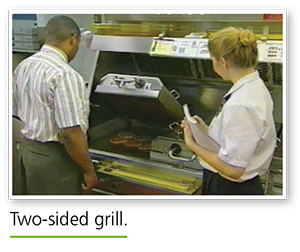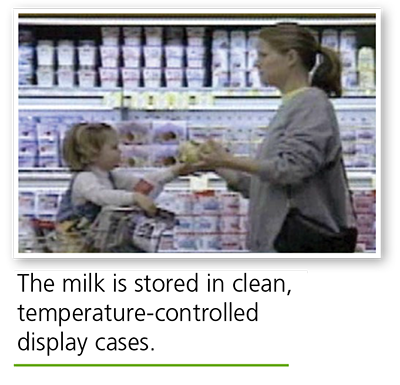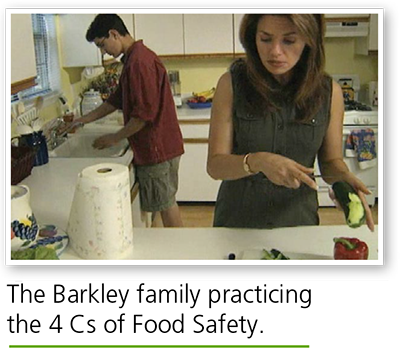Agricultural Literacy Curriculum Matrix
Lesson Plan
Supermarket Smarts
Grade Level
Purpose
In this activity, students will develop an awareness of the importance of food safety in retail food establishments. They will be challenged to design and manage their own food-safe supermarket department using the 4 Cs of Food Safety. At the end of this activity, each team will present its findings in an innovative presentation. Grades 6-8
Estimated Time
Materials Needed
- Assorted materials for students to prepare class presentations
- Grocery bag
- Dr. X and the Quest for Food Safety video, Module 4 — Retail and Home
Advance Preparation
- Write the names of each supermarket department on a separate piece of paper. (These departments offer a good variety of food safety principles.)
- Meat/Poultry/Seafood
- Deli
- Produce
- Dairy/Eggs
- Checkout
- Employee break area
- Place the papers in a grocery bag, and place the bag on your desk.
Vocabulary
food safety: the practice of handling, preparing, and storing food in a way that prevents food-borne illness
Background Agricultural Connections
Students purchase food from retail establishments. Exploring all the aspects of safe food handling in a supermarket (or fast food restaurant) will help make them better consumers and employees.
Retail Food Safety
The 4 Cs Connection — In any restaurant or place that serves food, the 4 Cs are critical. Sometimes, the 4 Cs can be taken care of by technology.
 Hi-Tech Hamburgers – Fast-Food Technology
Hi-Tech Hamburgers – Fast-Food Technology
To eliminate human error, an engineer developed a 2-sided “clam shell” type grill that has a temperature sensor. It cooks burgers on both sides simultaneously, using a sensor to ensure that all of the burgers reach a safe internal temperature.
Important Note: The “clam shell grill” is only one way to ensure safer food. Other methods, such as cooking on a grill and flipping burgers, are also effective. The point is to ensure that foods are cooked to a high enough temperature to kill any pathogens.
Handwashing
Humans are one of the biggest sources of food contamination in restaurants. So, proper handwashing is critical to keep food safe. For example, contamination can occur when someone doesn’t wash his or her hands and then prepares or serves food.
 Supermarkets
Supermarkets
Receiving areas are maintained at cold temperatures of 41° F (5° C) or below to maintain the cold chain that started way back in the field.
Storage areas and display cases are kept clean and temperature controlled.
Food preparation areas are also kept clean, and are set up to avoid cross-contamination.
Foods are always separated to avoid cross-contamination. Red meats, fish, and poultry will never be mixed together or mixed with fruits and vegetables.
Food Safety at Home
Even with all the great technology, food can still become contaminated, so it’s important for YOU to always practice the 4 Cs of Food Safety. Once you purchase food and take it home, the responsibility for food safety is literally in your hands.
 Overview of 4 Cs in the Home
Overview of 4 Cs in the Home
Clean — Wash hands and surfaces often. Wash hands with warm, soapy water, and cutting boards, dishes, utensils, and surfaces with hot, soapy water before and after food preparation.
Cook — Cook foods to proper temperatures. Using a food thermometer is the only reliable way to ensure that hamburgers, meat, and poultry reach a safe internal temperature.
Chill — Refrigerate promptly. Refrigerate or freeze foods quickly because cold temperatures keep harmful bacteria from growing and multiplying. Follow the 2-Hour Rule: Refrigerate or freeze perishables, prepared foods, and leftovers within 2 hours or less.
Combat Cross-Contamination (Separate) — Keep raw meats, poultry, and seafood — and the juices from raw foods — away from other foods in your shopping cart, on kitchen counters, and in your refrigerator.
 Science and our Food Supply
Science and our Food Supply
This lesson was developed as a portion of an entire unit of lessons focusing on food safety from farm to table. Use the following links to see the remaining lessons:
Module 1: Bacteria
Module 2: Farm
Module 3: Processing and Transportation
Module 4: Retail and Home
- Supermarket Smarts
- Cooking Right: The Science of Cooking a Hamburger
- A Chilling Investigation
- Crossed Up!
- Hands Off, Bacteria!
Module 5: Outbreak and Future Technology
Evaluation: Lose a Million Bacteria (The Game)
Engage

- Engage the students by saying, "I have a challenge for you! Today we’re going to take on the role of managing specific departments in a supermarket. But before we begin, let’s find out what Dr. X and Tracy have to say about food safety at the supermarket and in restaurants."
- Here are some questions to think about while you’re watching the video:
- How do supermarkets practice the 4 Cs?
- How are supermarkets a link in the cold chain?
- What does Dr. X mean when he says, “The responsibility for food safety is literally in your hands”
- Show video Module 4, Part 1 — Retail (Time: 3 minutes).
Explore and Explain
- Divide the class into 5 teams.
- Have a member from each team select a department from the grocery bag. Tell the teams, "Today, you’ll be the manager of your supermarket department. Your challenge is to reduce the opportunity for foodborne pathogens to grow or spread. Work with your teammates to create a food safety program for your department."
- Have each team develop a plan for ensuring that the food in their department is safe, and prepare an innovative presentation to present their plan. Students can consider the following actions:
- Research the food safety needs of the department by using the Internet and/or interviewing a store manager.
- Research local, state, and federal regulations to find out what procedures the store personnel must follow.
- Design the department so that it follows the 4 Cs of Food Safety.
- Analyze the role of the 4 Cs of Food Safety within the department.
- How does the cold chain come into play in the department?
- Include handwashing recommendations for the employees.
- Present the department design to the class, and show how food safety was incorporated into the department. Make a PowerPoint® presentation, blog post, web page, poster, advertisement, poem, song, play, or 3-D model. Or, come up with another original idea.
- Have the class compare the food safety needs found in each of the five departments. Ask students: What are the similarities and differences?
Elaborate
-
Interview a local supermarket manager and find out how he or she ensures food safety.
-
Create an FBI Case scenario about what happens to the food between the time you take it out of the supermarket and get it home. Build in at least three 4 C violations. You can also try to identify the violations and then propose a plan for minimizing the risk.
-
Trace a food through the supermarket. How is it kept safe until you purchase it? How many times is it touched, and by whom? Is there a way to ensure that all those who touch the food have clean hands? Report your findings.
Evaluate
- Dr. X told us that supermarkets are “major 4 C territory.” What did he mean by that?
- Clean — Employees in restaurants and food stores must clean their hands. Storage areas and display cases must be kept clean as well.
- Cook — Temperature probes should be used to make sure that food is cooked to the right temperature.
- Chill — Foods need to be chilled or frozen to stay fresh.
- Combat Cross-Contamination (Separate) — Food-preparation areas must be kept clean to avoid cross-contamination. There are separate departments for raw meat, fish, poultry, and produce to avoid cross-contamination.
- Dr. X discussed the “cold chain.” What is it? (The cold chain is a series of actions that maintain the temperature of food as it travels from the farm to the table.) How does the cold chain come into play in the supermarket? (Supermarkets are a link in the cold chain. Storage areas and display cases are kept at safe temperatures to keep food frozen or chilled.)
- What does Dr. X mean when he says, “The responsibility for food safety is literally in your hands”? (Handwashing is critical to keeping food safe. Contamination can occur when someone doesn’t wash his/her hands and then prepares or serves food. Employees must follow strict handwashing guidelines, and customers should wash their hands before they eat the food, and before preparing and eating food at home.)
Acknowledgements
The Science and Our Food Supply Curriculum was brought to you by the Food and Drug Administration Center for Food Safety and Applied Nutrition and the National Science Teachers Association.
- FDA Education Team Leader Food Safety Initiative: Marjorie L. Davidson
- FDA Science and Our Food Supply Project Director: Louise H. Dickerson
- FDA/NSTA Associate Executive Director and Science and Our Food Supply Program Director: Christina Gorski
- FDA/NSTA Science and Our Food Supply Program Assistant: Jill Heywood
Recommended Companion Resources
Author
Organization
| We welcome your feedback! If you have a question about this lesson or would like to report a broken link, please send us an email. If you have used this lesson and are willing to share your experience, we will provide you with a coupon code for 10% off your next purchase at AgClassroomStore. |
